Minds On
Let’s get started!
Sometimes people hire moving companies to help them move.
Movers pack all the items onto a truck and safely deliver them to a new location.
Examine the following image and description.
 Description
Description
An adult and a child scratch their heads in a puzzled manner as they look at the objects behind a moving truck. There is a large sofa and multiple large boxes marked heavy.
Imagine there is a heavy piece of furniture that needs to be moved onto a truck.
- How would you do it?
- Would you use a tool or a device to help you?
Records your ideas digitally, orally, or on paper. If possible, share your ideas with a partner.
Action
Experiment time!
Let’s return to the scenario in the Minds On.
How would you move a heavy piece of furniture onto the truck?
Would you try to lift it over your head?
Would you use a rope?
Would you use a ramp?

Let’s use an experiment to explore different ways to move a load.
It’s time to experiment!
The following experiment will help to you explore how to move a load more easily.
Safety
Before you explore the experiments, let’s perform a safety check.
Experiment 1: How to move an object more easily
Hands-on Science
Hands-on science
Check out the materials needed and the experimental procedure for the Moving a Load experiment.
If you have access to the materials, use the Accordion to follow the steps of your experiment.
If you do not have access to the materials, check out the following video entitled, ‘Video demonstration’ after the Accordion to explore the experiment in action. Then, use the video to predict what you think will happen and make your observations and conclusions.
Check out the following list of materials you will need, if possible:
- a ruler or metre stick (the ruler should be at least 30 centimetres (cm) long)
- stack of books (10-15 depending on their size. The stack should be up to 20 cm tall)
- a heavy book or another object that can be used as a load
- string (enough to wrap around and lift your load)
Carefully consider each of the following steps for your experiment.
Step 1: First, stack the books in a pile. Pick the heaviest book.

Step 2: Take your heaviest book and place it on the table. Then, tie the string around the heavy book. This heavy book is considered your load. Try to lift it on top of the stack of books. Record your observations.

Step 3: Now create a ramp by resting one end of the ruler on top of the book stack and the other end on a table.

Step 4: Finally, place the heavy book (load) at the bottom of the ramp. Using one hand, pull on the string to move the book up the ramp. Record your observations.

Check out the following video to explore a demonstration of the Moving a Load experiment.
Please note, that the materials and steps in the video may be a little different from what is listed in the previous tabs.
Consider the following questions about your experiment:
- What did you predict would happen? Were your predictions correct?
- How do the results of your string and ramp tests compare? Which object made it easier to move the load from the bottom to the top?
Complete the following fillable and printable document Lab Sheet: Moving a Load or record your ideas digitally, orally, or on paper.
|
Materials |
|
|
Prediction What do you think will happen? |
Use pictures and/or words to record your prediction(s). |
|
Steps |
Step 1: First, stack the books in a pile. Step 2: Then, tie the string around the heavy book (load) and try to lift it on top of the stack of books. Record your observations. Step 3: After that, create a ramp by resting one end of the ruler on top of the book stack and the other end on a table. Step 4: Finally, place the heavy book (load) at the bottom of the ramp. Using one hand, move it up the ramp. Record your observations. |
|
Observations Consider the following questions:
|
Record what you notice using pictures, numbers, and/or words. |
|
Think Consider the following questions:
Explain your thinking. |
Record your ideas using pictures, numbers, and/or words. |
Press the ‘Activity’ button to access Lab Sheet: Moving a Load.
Inclined planes
You probably noticed it was easier to move the load using a ramp.
Lifting a heavy load takes a lot of effort or force!
Press ‘Definition’ to learn more about what a force is.
A force is any push or pull.
But people can use simple machines to make work easier and fun!
The ramp is a type of simple machine called an inclined plane.
An inclined plane makes it easier for people to move a load from a lower level to a higher level (and the other way around).
Instead of lifting something straight up, movers can push or pull it up an incline.
It does not reduce the amount of work, but it does make it easier.

It is easier for the movers to roll a heavy object up a ramp than to lift it up into a truck. You might have to move an object across a longer distance, but a ramp makes it much easier to move a load up or down.
The inclined plane is one of six simple machines.
All simple machines make work easier and faster.
The simple machines are:
- lever
- pulley
- inclined plane
- wheel and axle
- wedge
- screw
Press the following tabs to learn all about the six different simple machines.
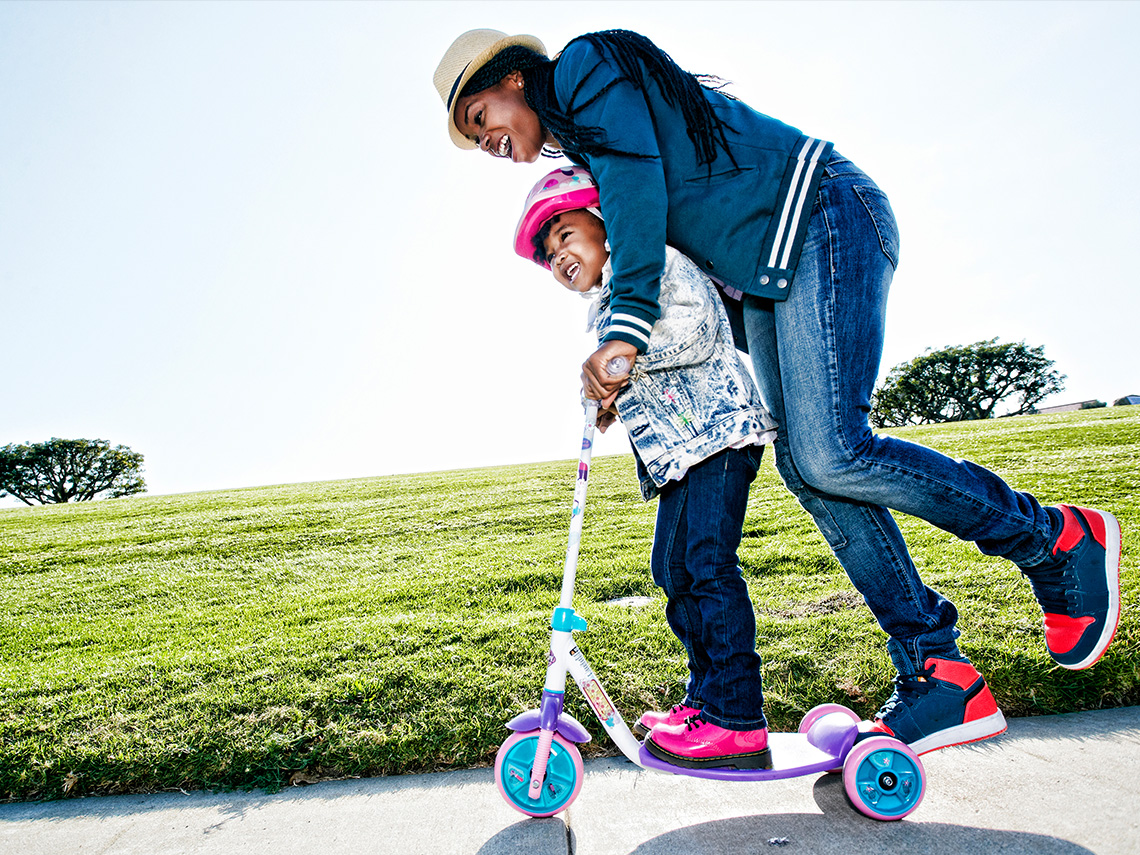
This scooter is a simple machine. It has wheels and axles. A wheel is what makes the scooter go round and round. An axle is a small rod or stick that goes through the wheel and helps move the wheel around. It can be long or short.
Explore the following animation. Do you notice the wheel? Do you notice the axle?
They are working together!
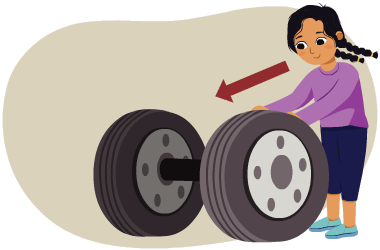 Description
Description
A learner is pushing one of two wheels that are attached to each end of an axle. An arrow shows she is pushing forward. The wheels move easily.
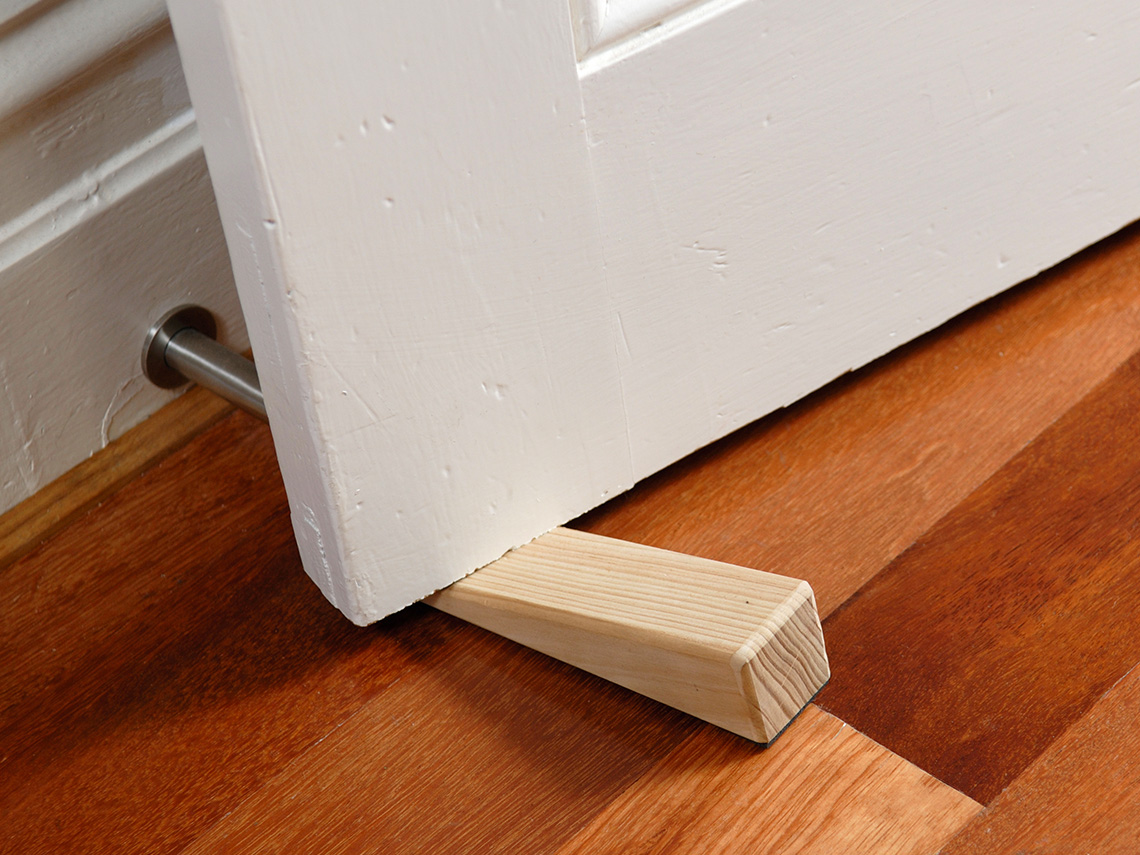
The doorstop is a simple machine. It is a wedge! A wedge has at least one side that is slanted. A wedge can hold something in its place or pull something apart.
Explore the animation. Do you notice a slanted side? Is the wedge pulling something apart or holding something in its place?
 Description
Description
A person is using an axe to cut a log into two pieces. An arrow shows the downward direction of the axe. Two arrows, one to the right and one to the left, show the direction the chopped pieces of wood fall.

A clothesline is a simple machine. It is a pulley! A pulley uses a wheel and a rope to move and object. It can also pull an object up or pull it down.
Explore the animation. Do you notice the rope? Do you notice the wheel?
They are working together!


A teeter totter is a simple machine. It is a lever! A lever is a bar that has a piece in the middle of it. It’s called a fulcrum. It makes the bar move up and down.
Explore the animation. Do you notice the bar? Do you notice the fulcrum?
They are working together!
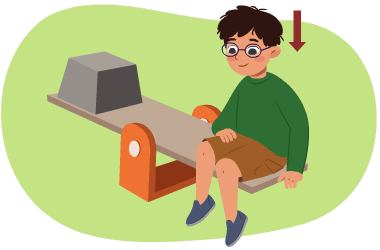

A slide is a simple machine. It is called an inclined plane! An inclined plane is a thing that is slanted which means it is not flat. There is a lower point and a higher point. This makes it easier to move something. A slide that was flat just wouldn’t work!
Explore the animation. Do you notice the inclined plane? Does it have a lower point? And a higher point?
This makes it easier to move something.


The water bottle cap is a simple machine. It is a screw! A screw holds things together. It has ridges around it called threads. The water bottle also has ridges around it and when you put the cap on, they match up. You can make a screw tighter by turning it one way and looser by turning it the other way.
Explore the animation. Do you notice the screw? How is it being turned?
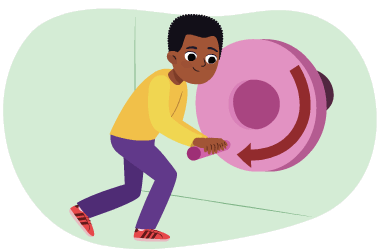
Did You Know?
How did they do it?
People have used simple machines to do work for a long, long time.
Take, for example, the pyramids in Egypt. Explore the following image of the pyramids.

The pyramids were built long before modern machines such as excavators, dump trucks, bulldozers, and cranes were invented.
We’re still not totally sure how people built these incredible structures.
But researchers believe people used different simple machines like the inclined plane and lever to help them build pyramids.
How simple machines work
Explore the following video entitled “Finding Stuff out with Zoey: Machines” to explore how simple machines help people do hard work!
Then, respond to the questions that follow.
Respond to the following questions:
Record your ideas digitally, orally, or on paper. If possible, share your ideas with a partner!
Megan and Zoey tested different simple machines to understand how they work.
What simple machine might help someone lift an object up by pulling a rope?
Press ‘Answer’ to explore one possible answer.
A pulley.
What simple machine might help someone move an object from a lower level to a higher level? Press ‘Answer’ to check out the answer.
An inclined plane.
What simple machine might help someone hold things together?
Press ‘Answer’ to access the answer.
A screw.
At the end of the clip, Zoey thinks again about her question: “How did the Ancient Egyptians build the pyramids without using any machines?”
Press ‘Answer’ to check your learning.
After learning about simple machines with Megan, Zoey thinks that people used simple machines to build the pyramids.
What do you think? What simple machines do you think people might have used to build the pyramids. Explain your thinking.
What are some simple machines that you use to make work easier?
Consolidation
Putting it all together
Check your understanding
Which simple machine would make the following tasks easier?
In the following Matching activity, choose the simple machine that best fits the task!
Simple machines scavenger hunt
Think about where you might find simple machines in daily life.
Consider your learning space, where you live, and/or your community.
Record as many as you can think of.
Then, explain what each one is used for. How does it help make work easier?
Complete the Simple Machines Scavenger Hunt in your notebook or using the following fillable and printable document.
|
Simple machine |
Simple machine(s) found |
What does it do? How does it make work easier? |
|---|---|---|
|
lever 
|
||
|
pulley 
|
||
|
inclined plane 
|
||
|
wheel and axle 
|
||
|
wedge  Description
Description
A person uses an axe to cut a log into two pieces. An arrow shows the downward direction of the axe. Two arrows, one to the right and one to the left, show the direction the chopped pieces of wood fall. |
||
|
screw 
|
Press the ‘Activity’ button to access Simple Machines Scavenger Hunt.
Reflection
How do you feel about what you have learned in this activity? Which of the next four sentences best matches how you are feeling about your learning? Press the button that is beside this sentence.
I feel…
Now, record your ideas about your feelings using a voice recorder, speech-to-text, or writing tool.